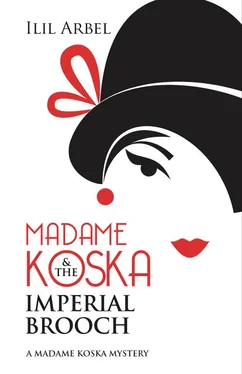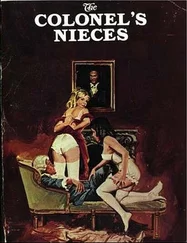Ilil Arbel
MADAME KOSKA & THE IMPERIAL BROOCH
Dedicated to my son Alan M. Arbel,
whose expertise in the genres of literary
and true crime was an inspiration,
and my daughter-in-law Rachel Levine-Arbel,
who truly understands the joy of
the world of high fashion.
I would like to thank all the wonderful people who went beyond the call of duty to help with this book. They are listed in alphabetical order of their last name, since how else could I establish precedence?
Ms. Kathleen Fish
Dr. Penelope Fritzer
Ms. Barbara Houlton
Mr. Gary Morgenstein
Lord David Prosser
Ms. Janet Schmelzer
Mr. Jay Strafford
Ms. Susan Verell
Ms. Louanne M. Wheeler
Mr. Wayne Zurl
In the beginning, Anthony Trollope created Barset and Barchester. [1] I sadly realize it does not have the same thunder as “the Heaven and the Earth” but we are not Yahweh…
And he saw that they were good. Five great tomes had been writ, and he was labouring on the sixth, when a dreadful calamity befell the mighty author. As he sat meditating at the Athenaeum Club, a conversation between two clergymen reached his ears; they were disparaging the beauty of his creations, calling his Barchester characters tired and over-familiar. Great rage seized the literary giant. He rose from his seat and strode toward the offending vicars. “I shall not write another Barchester novel,” he thundered. “And the anger of my readers will follow you unto the seventh generation, since it was your doing and yours alone.” Pale and frightened, the clergymen begged him to reconsider, fearing for their very lives. He refused. “At least finish the novel you are creating now,” said one of them, trembling like a leaf, “Or you will be our death.” Trollope’s kind heart relented a little, and he promised them he would finish that novel, but no more. “You shall not perish,” he added, “but the book will be named The Last Chronicles of Barset .” [2] Okay, so the story is slightly embellished. The overhearing itself is definitely true.
And so it came to be. The mighty author moved on to the political novels, and never returned to his beloved Barchester, which is a great pity since I would have liked to read more about Signora Neroni and the rest of the Stanhope family.
Time passed and Barchester could only be visited through the six portals of the great novels. And then, in the early thirties, a brave clergyman whose name was Ronald A. Knox, moved to create more Barchester stories. One great tome of short stories named Barchester Pilgrimage had been writ, and he saw that it was good. [3] Well, maybe “good” is a strong word. The stories are pretty boring, but at least someone tried .
Silence reigned again until the descendant of other mighty authors and artists, Angela Thirkell, returned to Barchester through her many novels about the descendants of the characters introduced by Trollope. No need to go any further since every single person reading this introduction knows her. Hopefully, they also know my books, Miss Glamora Tudor! and Their Exits and their Entrances . They were bundled under what I hoped was the significant name of The New Chronicles of Barset .
These books were about Glamora Tudor, the legendary actress who never comes on stage in any of the Angela Thirkell books, but whose presence permeates the very atmosphere of Barsetshire with its “It” factor. I made her come on stage in Glorious Technicolor, and that, apparently, became a precedent. It was determined by the Powers Who Should Remain Nameless that it would be a nice idea to bring to life another character for whom we had been given only tantalizing glimpses…
So here she is. Madame Koska, the elusive, enigmatic, undefeatable Madame Koska, who can solve a crime and run an establishment of magnificent haute couture with equal success. We know she is the regular heroine of our beloved Mrs. Morland, but that is almost all we know. What is her first name? Who was M. Koska? Where did she learn her trade? It must be Paris but she has a Russian name… where does she get her lovely mannequins? Does she smoke a cigarette stuck in a long ebony cigarette holder? Does she really look the way I imagined her, Maggie Smith while in her late forties or so? She never has to age, even if I write a book a year… after all, Bertie Wooster did not age over his forty years of glory… So many questions, and they all have to be answered on the run, since she is busy solving the very first Madame Koska mystery in the very first Madame Koska novel. The year is 1921 (calculated since Laura Morland started writing while still educating her older three children, about 12 years before High Rising , which was published in 1933).
And who is really writing it? Is it me, Ilil, aka Mrs. Morland? Is it Mrs. Morland, aka Mrs. Thirkell? I am getting a headache… but it’s a small price to pay for the privilege of being the alter ego of an alter ego… strange and wonderful. I sincerely hope you enjoy it, because I am afraid that if I don’t go on and write a book a year, Mrs. Morland might be upset… or Mrs. Thirkell… and they will stop channeling me! We can’t have that!
“Anyone here? Where are you?” The lady stood in the middle of the large, empty room, her chocolate-colored eyes flashing with anger as she stared at the incomplete renovations. Buckets of creamy white paint, brushes, and other painting paraphernalia were scattered around the cloth covering the floor. “Where is everyone?” she cried again. There was no answer. With a sweeping motion she flung her embroidered, elegant black shawl around her shoulders, and without removing her black fur hat, which added considerable height to her already slim and tall figure, strode up the stairs, negotiating her high heels with ease. “The pigs,” she murmured, quickly correcting herself and saying “ Les cochons .” One must keep one’s style even when alone, as she was always trying to remember.
On the upper story’s little hall she burst into one of the rooms, then stopped suddenly and gazed at its perfection. The walls glowed with their fresh coat of paint; the parquet was polished to a deep shine. She sighed with relief and went downstairs again, reaching the empty room just as the two workmen returned from their lunch.
“Why have you not finished the house?” she asked, her voice shrill and accusing. “You absolutely promised to finish by tomorrow! I fully relied on you! The furniture is arriving on Friday, and where shall I put it? I will not pay! I will complain! You will be instantly dismissed!” She almost stamped her foot but must have remembered the danger it could present to her high heel, and stopped herself in time. Instead she decided to wring her hands, a most impressive gesture since it allowed the many rings she wore on top of the white gloves to flash and sparkle in the sun-drenched room.
“But Maidum Koska, she is going to be finished tomorrow. There is only one wall left, and then we polish the floor, easy,” said the older man, smiling at her. “And look at the windows, them too is done so beautifully.”
Madame Koska, somewhat mollified, went to the window. She had to admit that the windows were very well repaired, the terrible drafts that came from the loosened glass all gone. And not a single drop of paint landed on the glass! She smiled at the workers with utmost good nature that no one would have believed could be achieved so quickly after the tempest, and stepped over to the door as another lady entered the apartment.
Читать дальше













